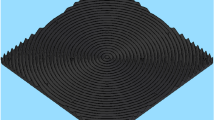Abstract
The calibration accuracy of High Resolution Infrared Radiation Sounder Mod. 2 (HIRS/2) on NOAA-10 satellite is analyzed in this paper. The non-linear effect in the linear calibration curve induces a deviation of 1.5 degrees (k) of brightness temperature in the tenth channel (8.3 um, water vapor absorption) of the HIRS/2 and the non-linear effect affects the other channels to a different extent. Based on analyzing non-linearity in two-point calibration curve, a tri-point calibration equation is given. A numerical test of effects of the linear and non-linear calibration models on the accuracy of atmospheric temperature retrievals is carried out.
Similar content being viewed by others
References
Lauritson, L., G. J. Nelson, and F, W. Porto (1979), NOAA Technical Memorandum NESS 107, Washington, D. C., 58pp.
Wyatt, C. L. (1978), Radiometric Calibration:Theory and Methods. Academic Press, New York, 200 pp.
Author information
Authors and Affiliations
Rights and permissions
About this article
Cite this article
Dong, C., Liu, Q., Li, G. et al. The study of in-orbit calibration accuracy of NOAA satellite infrared sounder and its effect on temperature profile retrievals. Adv. Atmos. Sci. 7, 211–219 (1990). https://doi.org/10.1007/BF02919159
Received:
Issue Date:
DOI: https://doi.org/10.1007/BF02919159




